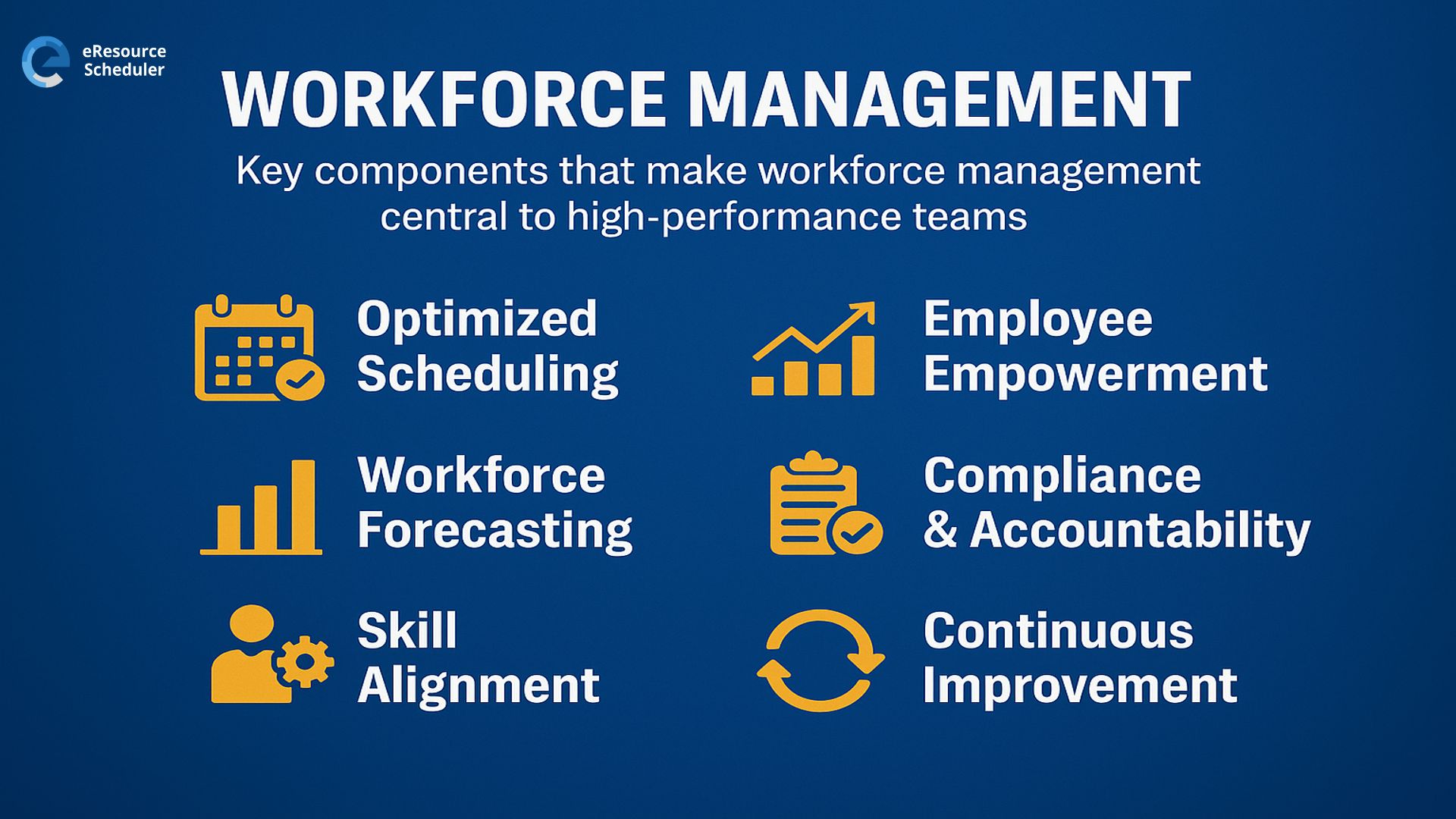
What makes a team truly high-performing? It’s not luck, it’s precision. Ask any manager what fuels a high-performing team, and you’ll hear the same mantra: Right people. Right roles. Right timing. Right cost. Right skills. However, in reality, achieving that balance requires data-driven foresight, dynamic scheduling, and agile resource management, precisely what modern businesses are now perfecting.
A successful workforce planning strategy helps organizations build the capabilities they need for the future. Employees are every firm’s most valuable asset, and yet workforce management often lacks the structure it deserves. Many businesses still struggle with limited visibility into their current and future staffing needs.
Without a consistent, data-driven approach to workforce planning, inefficiencies creep in and impact both the top and bottom lines. And while leaders recognize its importance, effective implementation remains one of the biggest challenges organizations face today.
Workforce management is the practice of aligning your team’s capacity and capability with the organization’s current and future demands. In simple terms, it’s about ensuring you have the right people, with the right skills, available at the right time. Done right, WFM bridges the gap between workload and workforce, enabling smarter resourcing decisions and higher productivity.
At its core, it is an integrated process that connects multiple business functions from HR and talent management to labor tracking, leave planning, and workforce analytics. Together, these systems help organizations plan better, measure performance accurately, and optimize staffing continuously.
Modern resource management tools take this a step further. With real-time insights and cloud-based flexibility, managers can track performance, schedules, and engagement anytime, anywhere. Whether teams are in the office, remote, or hybrid, WFM software ensures smooth coordination and accountability.
Real-time dashboards and analytics help managers monitor productivity and offer instant feedback, turning routine tasks into motivators. Like a fitness app for work, it keeps performance measurable and morale high.
Analytics pinpoint skill gaps, helping organizations tailor training programs that actually improve output and engagement.
WFM software prevents burnout by optimizing shifts, reducing unplanned overtime, and forecasting staffing needs in advance.
With mobile access, employees can stay connected from anywhere, thus improving coordination, work-life balance, and job satisfaction.
Visibility tools highlight reliable, high-performing employees, ensuring recognition and rewards don’t get lost in the crowd.
Self-service features let employees manage schedules and timesheets independently. This autonomy builds trust and accountability.
Automated time tracking ensures fair pay, precise accruals, and compliance, ultimately fostering transparency and employee confidence.
When thoughtfully implemented, it doesn’t just streamline operations; it transforms how teams work, collaborate, and grow. The result? A more efficient, motivated, and future-ready workforce.
High-performance management is a strategic approach that helps organizations track, evaluate, and improve employee productivity to ensure goals are consistently met. The aim isn’t just to push people harder but to actually build an ecosystem where employees can thrive, succeed, and realize their full potential while driving organizational growth.
While HR teams champion high-performance management to accelerate business outcomes, employees benefit just as much. It opens doors to:
Building a high-performance team isn’t just about hiring skilled people; it’s about synchronizing talent, timing, and teamwork. A truly high-performing team is adaptable, data-driven, and empowered to make informed decisions. Members know what’s expected, understand how their work ties to business goals, and have the tools to deliver consistent results.
Workforce management goes beyond scheduling or attendance tracking because ultimately, it’s the framework that sustains performance. Aligning staffing levels, skills, and availability with real-time demand ensures every role is filled by the right person at the right moment.
Once limited to matching employee capacity to call volume, workforce management now drives performance across industries from healthcare and manufacturing to consulting and retail. It’s evolved into a strategic function that helps companies forecast needs, balance workloads, and minimize burnout.
Key components that make workforce management central to high-performance teams:

When done right, organizations hit goals faster and smarter while also empowering employees and ensuring balance.
Building a high-performing team isn’t a one-time project but an ongoing system that thrives on clarity, balance, and visibility. That’s exactly where eResource Scheduler (eRS) steps in.
eRS brings the science of resource management to life, helping businesses plan capacity, forecast demand, and allocate people with precision. No more messy spreadsheets or reactive scheduling, just one centralized platform that gives leaders real-time insight into availability, workload, and utilization.
With color-coded heatmaps, drag-and-drop scheduling, and real-time dashboards, resource scheduler transforms how managers make decisions. You instantly see who’s overbooked, who’s underutilized, and how workloads align with capacity. The result? Optimal resourcing, faster delivery, and happier, less-stressed teams.
But it’s not just for managers. eRS empowers employees, too, by giving them visibility into their schedules, letting them manage shift swaps, and promoting work-life balance through flexibility. When people feel in control of their time, performance naturally rises.
From consulting firms and IT services to healthcare and engineering, wherever teams depend on smart resource allocation, eRS keeps operations agile, compliant, and cost-efficient.
Understanding workforce management is one thing, and mastering it is another. Even with advanced systems in place, true success comes from applying the right principles consistently. High-performing organizations embed these practices into their culture, turning strategy into habit.
High-performing teams are built on trust, not control. When employees believe in their leaders and in one another, collaboration flows effortlessly. Trust gives people the confidence to take initiative and the freedom to innovate, turning teams into cohesive powerhouses.
Goals are the backbone of performance. Clear objectives guide decisions and keep everyone moving in the same direction. Modern performance dashboards make it easier to track progress, identify roadblocks early, and make data-backed course corrections before they snowball into issues.
Recognition isn’t optional; it’s essential. When teams hit a target, pause to celebrate. Appreciation amplifies engagement, reinforces shared purpose, and reminds employees that their contributions matter.
Conflict is natural, but dysfunction is not. Address disagreements early, privately, and with empathy. A transparent approach to conflict resolution builds psychological safety, ensuring teams remain focused on performance, not politics.
High performance, in the end, isn’t about perfection. It’s about consistency, clarity, and the ability to adapt.
High-performing organizations don’t rely on luck. They rely on clarity, data, and discipline. With eResource Scheduler, workforce planning becomes proactive instead of reactive, helping businesses stay ahead of demand while empowering teams to do their best work.
The path to sustainable performance lies in mastering the balance between people and projects, and eRS gives you the tools to do exactly that. From visual scheduling and real-time utilization tracking to what-if planning and reporting, it’s everything you need to build a workforce that grows with your business.
Ready to make high performance your default setting?
Schedule a demo with our experts today and see how eResource Scheduler helps you plan smarter, allocate better, and perform stronger every single day.
1. What are the key goals of workforce management?
The main goal of workforce management is to align employee capacity, skills, and availability with business demand. This ensures optimal utilization, prevents overbooking or idle time, and helps organizations deliver projects on time and within budget.
2. How does workforce management software improve team performance?
Workforce management software like eResource Scheduler gives managers real-time visibility into availability, workload, and utilization. With features such as drag-and-drop scheduling, forecasting, and analytics, it enables smarter planning, balanced workloads, and better employee engagement.
3. What’s the difference between resource management and workforce management?
Both aim to optimize how people and skills are used, but resource management focuses on allocating people to specific tasks or projects, while workforce management covers the broader spectrum, including scheduling, time tracking, performance, and compliance.
4. How can organizations build and sustain high-performance teams?
High-performance teams thrive on trust, clear goals, regular feedback, and autonomy. Using tools like eResource Scheduler helps managers track performance, align skills with tasks, and empower employees, turning everyday teams into high-performing ones.
5. Why is real-time visibility important in workforce management?
Real-time visibility helps leaders spot overutilization, underuse, or conflicts instantly. It supports faster decisions, proactive adjustments, and accurate forecasting, key ingredients for efficient operations and happier, more productive teams.
Plan Smarter. Schedule Faster.
Join thousands already using eResource Scheduler to align teams, time, and tasks seamlessly.